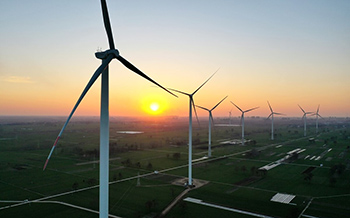The popularity and development of wind turbines are extremely rapid. The effect and function of wind turbines are also huge. If we can master some common fault judgments when using wind turbines, we may reduce unnecessary losses when the wind turbine fails. Next, we will introduce the fault diagnosis of wind power generation in detail.
Acquisition system and software design
The data acquisition system mainly converts the signals of various sensors into acceptable signals through A/D, and sends the signals back to the data storage module. The acquisition boards have different working modes, and the two commonly used are roving acquisition and synchronous acquisition. The former is that the acquisition card follows the corresponding rules and collects each signal in a targeted manner. The latter is the acquisition card through multiple channels, the signal is collected at the same time.
In practical applications, the synchronous acquisition method can better complete the monitoring of wind turbines. In the aspect of implementing the design software, the key components of the software modules of the system are the fault diagnosis module, the signal preprocessing module, the feature extraction module, and the auxiliary function module.
Important aspects of fault diagnosis of wind turbines
Wind turbines are usually located in environments with strong winds, generally in harsh areas such as wilderness and islands. However, the load generated by the wind has irregular characteristics, and it will produce a strong impact on thE wind turbine in the instantaneous state, which will cause the failure of the wind turbine. At present, the maximum speed of wind turbines can be as high as 1.500 revolutions per minute. During long-term high-speed operation, the gearbox will generate high temperature and heat. At the same time, under the action of the load, the gearbox will fail.
At present, the common faults of gearboxes include local faults and distributed faults. Local failures include gear damage, bending fatigue, etc. Distributed faults are divided into tooth surface wear, bearing damage and so on.
The types of failures that occur include the following:
First, broken teeth. After the gear is subjected to periodic stress, cracks will appear at the root. However, after a long-term load, the gear will have broken teeth.
Second, gear tooth surface fatigue. When the gearbox is in motion, under the action of mechanical mechanics, the generated force will cause the gear to slide relatively. And the tooth surface will appear pitting, destructive pitting and surface crushing. The gear tooth surface appears fatigued. The fault state is manifested as the meshing frequency of the vibration signal, the increase of the vibration energy and the increase of the energy amplitude.
Third, the tooth surface is glued. After the gear is subjected to high speed and heavy load, the gearbox is in a state of high temperature. At this time, the tooth surface is affected by high temperature and pressure, and wear on the tooth surface will occur. When the gears are sliding relative to each other, the tooth surfaces are not sufficiently lubricated, resulting in a gluing failure on the tooth surfaces.
Generator failure can be divided into stator winding failure and bearing failure. When a stator winding fault occurs, the windings are damaged, worn, and cracked. At this time, the winding cannot provide insulation. When a bearing fault occurs, different parts of the fault will generate different vibration signals. Taking rotor misalignment as an example, this type of problem will be classified as an eccentricity fault.
In addition, the rotor and stator are supported by bearings, and the bearings will bear a large radial load, which will cause the bearing to fail under the action of a large load. Under normal circumstances, the inner and outer rings of the bearing will be damaged, pitted, and worn, and the probability of failure will increase when the bearing is in a vibrating state.
Conclusion
Power supply is a big deal. For the daily maintenance and maintenance of wind power plants, it is an inevitable requirement and basis to ensure the normal power supply. Therefore, the relevant wind power station must ensure a stable quality requirement during construction. At the same time, the relevant regulations and requirements should be followed during the operation of the power station, and the professional knowledge and skills training and professional knowledge learning of the staff should be continuously improved. Strictly abide by the serious overhaul and maintenance of the working units of the wind power station every day, and avoid the occurrence of problems and failures from the details.
